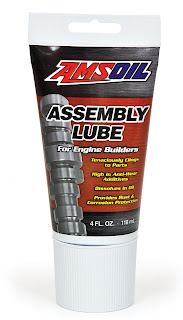Premium Protection for New and Rebuilt Engines
Amsoil assembly lube
FREE Amsoil Catalog, no obligation, 58 pages of good information sent via USPS
Amsoil assembly lube
New AMSOIL Engine Assembly Lube (EAL) is formulated to cling to engine parts and provide exceptional wear protection while inhibiting rust and corrosion in newly built or rebuilt four-stroke engines. It is designed to dissolve in oil, helping eliminate oil port clogging and deposit formation, and represents a premium option for performance enthusiasts, engine builders and race teams. It also presents a perfect complement to AMSOIL Break-In Oil (BRK), Dominator® Racing Oil (RD20, RD30, RD50) and Z-ROD™ Motor Oil (ZRT, ZRF).
Clings Tenaciously to Parts
Because building an engine can take from a few days to many months, using an engine assembly lube that clings well to parts for extended periods is critical. AMSOIL Engine Assembly Lube is formulated with a high-viscosity base oil and a unique tackifier for long-lasting, tenacious cling.
Exceptional Wear Protection
During initial startup, engines operate momentarily with little-to-no oil pressure, placing camshaft lobes, lifters, rocker arms, bearings and other critical parts at high risk of wear and failure. In addition to inhibiting wear by clinging to parts, AMSOIL Engine Assembly Lube contains high levels of antiwear additives for further protection.
Inhibits Rust and Corrosion
An engine can sit in a garage partially assembled for long periods, allowing moisture and oxygen to form rust on exposed metal surfaces. Amsoil assembly lube contains rust and corrosion inhibitors that protect engine components during inactivity.
Dissolves in Oil
Grease-based assembly lubes can increase the risk of oil port clogging if the grease is not fully consumed at initial startup, potentially causing engine failure. AMSOIL Engine Assembly Lube is designed to dissolve in oil, helping oil ports remain clean, and helping to eliminate deposit formation under the valve covers and in the oil pan.
Easy and Precise Application
Amsoil assembly lube is packaged in convenient 4-oz. tubes, allowing for cleaner, more precise application compared to other products.
Amsoil assembly lube
APPLICATIONS
AMSOIL Engine Assembly Lube is recommended for any new or rebuilt four-stroke engine, including racing and performance engines, and should be applied to all areas of the engine susceptible to initial startup wear.
- Tenaciously Clings to Parts
- High in Anti-Wear Additives
- Dissolves in Oil
- Provides Rust & Corrosion Protection
- Recommended for all Four-Stroke Engines, Including High-Performance and Racing Engines





